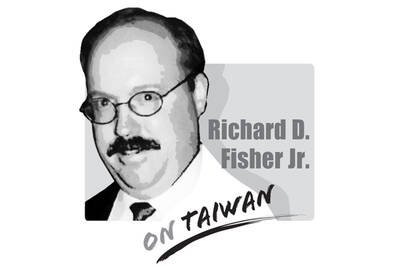On Monday evening, a violent skirmish between Chinese and Indian troops at their disputed border in the Himalayas ended in the deaths of at least 20 Indian soldiers and an unconfirmed number of casualties on the Chinese side. It is the most serious incident between the two nuclear-armed powers since the 1962 Sino-Indian border war.
While many details are still unknown about the incident at more than 4,000m above sea level, early signs indicate that the clash fits a pattern of Beijing’s increasingly aggressive expansionism in the region — which should also concern policymakers in Taiwan.
According to reports by Indian broadcaster New Delhi Television, citing Indian army sources, the incident started when an Indian army patrol tried to remove a Chinese tent pitched in the remote Galwan Valley. China reportedly agreed to remove the tent following talks with Indian army officers on June 6.
However, a fight broke out in which Indian soldiers were attacked by Chinese People’s Liberation Army (PLA) troops wielding nail-studded rods. Both sides called for reinforcements, and about 600 men were engaged in six hours of hand-to-hand combat.
An image of the studded iron rods, passed to journalists by an Indian senior military official, was published yesterday on the BBC’s Web site.
There is a longstanding convention between the two sides that each army patrols the 3,440km of disputed border at the Line of Actual Control (LAC) unarmed. The use of the medieval-style spiked clubs indicates a premeditated act, perhaps an ambush.
Chinese Ministry of Foreign Affairs spokesman Zhao Lijian (趙立堅) on Wednesday told reporters that Indian soldiers made an incursion across the LAC and called on India to “strictly discipline its frontline troops.” New Delhi strongly denies that its troops crossed the border.
The incident should be understood in the context of Beijing’s aggressive behavior in the region, which has clearly become more frequent since the outbreak of the COVID-19 pandemic.
The most egregious example is Beijing’s plan to impose national security legislation in Hong Kong in direct violation of the 1984 Sino-British Joint Declaration.
However, Beijing has also been engaged in hyper-aggressive “wolf warrior” diplomacy, most notably with Australia, and has been stirring up trouble in the South and East China seas.
In the past few months, the PLA has employed “gray zone” tactics, using maritime forces to ram a Coast Guard Administration vessel, a Japanese destroyer and to sink a Vietnamese fishing boat. Beijing has also unilaterally declared two new administrative zones covering the disputed Spratly Islands (Nansha Islands, 南沙群島) and Paracel Islands (Xisha Islands, 西沙群島) and increased provocative encirclement drills around Taiwan.
The rhetoric from Beijing toward Taiwan has become more belligerent. Talk of “peaceful unification” is increasingly replaced by threats of invasion.
What motivates Chinese President Xi Jinping’s (習近平) increased assertiveness in the region? This is a question that Taiwan, India and other regional nations must seek to answer.
Xi might feel emboldened by the COVID-19 pandemic and, more recently, racial tensions in the US, which from Beijing’s perspective, validate its belief that China’s political system is superior to increasingly atomized and decadent Western democracies.
On the other hand, Xi might be acting from a position of weakness, creating distractions while fighting rival factions within the Chinese Communist Party who have reached the end of their tether with his megalomaniacal style, interminable “anti-corruption” campaigns and cover-up of COVID-19 that have damaged China’s economy and international reputation.
Taiwan should deepen ties with India, in particular economic, military and intelligence ties, to contain Chinese expansionism and put Xi back into his box.
We are used to hearing that whenever something happens, it means Taiwan is about to fall to China. Chinese President Xi Jinping (習近平) cannot change the color of his socks without China experts claiming it means an invasion is imminent. So, it is no surprise that what happened in Venezuela over the weekend triggered the knee-jerk reaction of saying that Taiwan is next. That is not an opinion on whether US President Donald Trump was right to remove Venezuelan President Nicolas Maduro the way he did or if it is good for Venezuela and the world. There are other, more qualified
China’s recent aggressive military posture around Taiwan simply reflects the truth that China is a millennium behind, as Kobe City Councilor Norihiro Uehata has commented. While democratic countries work for peace, prosperity and progress, authoritarian countries such as Russia and China only care about territorial expansion, superpower status and world dominance, while their people suffer. Two millennia ago, the ancient Chinese philosopher Mencius (孟子) would have advised Chinese President Xi Jinping (習近平) that “people are the most important, state is lesser, and the ruler is the least important.” In fact, the reverse order is causing the great depression in China right now,

This should be the year in which the democracies, especially those in East Asia, lose their fear of the Chinese Communist Party’s (CCP) “one China principle” plus its nuclear “Cognitive Warfare” coercion strategies, all designed to achieve hegemony without fighting. For 2025, stoking regional and global fear was a major goal for the CCP and its People’s Liberation Army (PLA), following on Mao Zedong’s (毛澤東) Little Red Book admonition, “We must be ruthless to our enemies; we must overpower and annihilate them.” But on Dec. 17, 2025, the Trump Administration demonstrated direct defiance of CCP terror with its record US$11.1 billion arms
As technological change sweeps across the world, the focus of education has undergone an inevitable shift toward artificial intelligence (AI) and digital learning. However, the HundrED Global Collection 2026 report has a message that Taiwanese society and education policymakers would do well to reflect on. In the age of AI, the scarcest resource in education is not advanced computing power, but people; and the most urgent global educational crisis is not technological backwardness, but teacher well-being and retention. Covering 52 countries, the report from HundrED, a Finnish nonprofit that reviews and compiles innovative solutions in education from around the world, highlights a